Wikipedia:VideoWiki/Measles (Osmosis)
| VideoWiki/Measles (Osmosis) (Tutorial) | |
|---|---|
| File:En.Video-Measles (Osmosis).webm | |
| Link to Commons | |
| Steps for video creation | |
| Step 1 | Preview my changes (10 sec) |
| Step 2 | Upload to Commons (10 min) |
This video is part of a collaboration between Osmosis.org and Wiki Project Med Foundation.
Author: Tanner Marshall, MS
Editor: Rishi Desai, MD, MPH
1[edit]
Measles is one of the most contagious infectious diseases, and remains a leading cause of death particularly among young children, especially in areas with low rates of vaccination.[1][2][3]

2[edit]
Measles is also called rubeola, which can easily get confused with German measles which is also called rubella—similar sounding names but very different viruses.[4][5]

3[edit]
Regular measles is caused by the measles virus, seriously, the species is the “measles virus”, of the genus Morbillivirus and family Paramyxoviridae.[1]

4[edit]
The reason why this guy’s so contagious is that it’s airborne, and spreads via tiny liquid particles that get flung into the air when someone sneezes or coughs, and can live for up to two hours in that airspace or nearby surfaces.[1][6] If someone breathes in that air or touches a surface and then touches their eyes, their eyes, or their mouths, they can become infected.[2] Measles is so contagious that if one person has it, 90% of nearby non-immune people will also become infected.[1]

5[edit]
Once the measles virus gets onto the mucosa of an unsuspecting person, it quickly starts to infect the epithelial cells in the trachea or bronchi.[7][8] Measles virus uses a protein on its surface called hemagglutinin, or just H protein, to bind to a target receptor on the host cell, which could be CD46, which is expressed on all nucleated human cells, CD150, aka signaling lymphocyte activation molecule or SLAM, which is found on immune cells like B or T cells, and antigen-presenting cells, or nectin-4, a cellular adhesion molecule.[7][9] Once bound, the fusion, or F protein helps the virus fuse with the membrane and ultimately get inside the cell.[7] Now this virus is a single-stranded RNA virus, and it’s also a negative sense, meaning it first has to be transcribed by RNA polymerase into a positive-sense mRNA strand.[7]
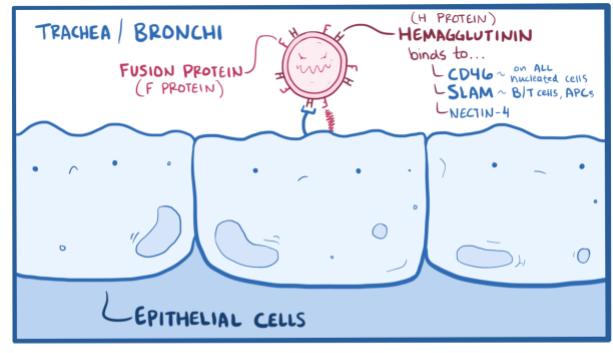
6[edit]
After that it’s ready to be translated into viral proteins, wrapped in the cell’s lipid envelope, and sent out of the cell as a newly made virus.[10] Within days, the measles virus spreads through local tissue and is picked up by dendritic cells and alveolar macrophages, and carried from that local tissue in the lungs to the local lymph nodes.[8][7]

7[edit]
From there it continues to spread, eventually getting into the blood and spreading to more lung tissue, as well as other organs like the intestines and the brain.[7][1]

8[edit]
Now it typically takes 10-14 days from the time that the virus entering the body to the beginning of symptoms, and this is the incubation period.[1][11] Once symptoms start, we’ve entered the prodromal period which typically lasts around 3 days, and starts with a high fever and the 3 C’s —cough, conjunctivitis—or inflammation and redness of the white part of the eye, and coryza—swelling in the mucous membrane of the nose, essentially a stuffy nose.[1][6] 1-2 days later comes the enanthem which is a rash on the mucus membranes, that looks like salt grains on a wet background.[12] These are called Koplik spots and are small white spots that are commonly seen on the inside of the cheeks opposite the molars.[11] After these initial prodromal symptoms comes the exanthem phase, which is where a red, blotchy, maculopapular rash spreads in a cephalocaudal progression.[1] In other words, the exanthem starts at the head (or cephalo), and spreads to the extremities or ends of the body (or caudal).[1]
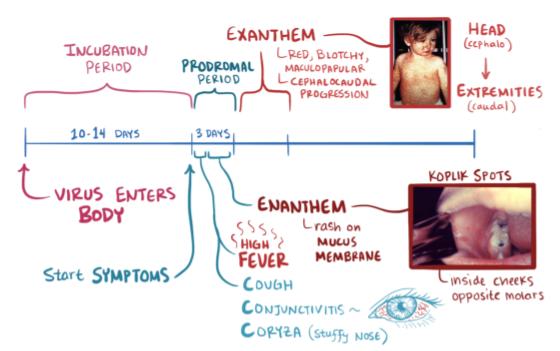
9[edit]
This rash fades after about 4 days, and leads into the recovery phase which can last for another 10-14 days, with the final symptom usually being a persistent cough.[7][13] In general, infected people are most contagious starting from the final day of the incubation period through the prodromal and exanthem phase, which roughly works out to be 4 days before to 4 days after the onset of the rash.[1] The good news is that once it’s all over and someone has recovered from measles they have lifelong immunity.[1]
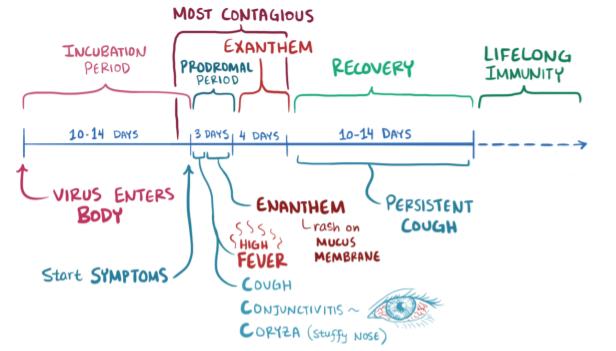
10[edit]
Since measles affects various organs like the lungs, intestine, and brain, it can lead to complications such as pneumonia, diarrhea, and, on rare occasion, encephalitis—all of which can lead to death.[6] In addition, measles can suppress the immune system, and this can contribute to bacterial superinfections like otitis media and bacterial pneumonia.[14][15][16] All of these complications are worst among young infants who typically have the highest rates of mortality during a measles outbreak.[3]

11[edit]
Another severe and often fatal complication for children under 2 years old is the development of subacute sclerosing panencephalitis, which can happen 7-10 years later.[1][7][6] This is thought to be caused by a persistent measles virus infection, possibly due to an abnormal immune response or a mutated strain of the measles virus, which leads to chronic inflammation of the entire brain.[7] The symptoms of SSPE are initially pretty subtle like for example, mood changes, but eventually become severe and dramatic, and can include seizures, coma, and if left untreated, death.[17]
For people who are immunocompromised (for example—people with HIVAIDS), their immune mediated responses are impaired, that being said if they get measles, they might not develop some symptoms that are a result of the immune system responding to the measles virus, like the enanthem (or the Koplik spots) or the exanthem (the rash).[7] These people though also have higher rates of pneumonia and encephalitis which contribute to a higher mortality rate.[7][11]

12[edit]
Diagnosis of measles is usually done via serology—looking for measles antibodies in blood serum, and the disease is usually most likely to occur among unvaccinated individuals.[7][1]

13[edit]
That said, the measles vaccine is a live attenuated immunization, essentially meaning it’s been weakened, and it’s given between 12-15 months of age and again between 4-6 years of age, and it has an impressive 95% vaccine efficacy rate, which means that out of a hundred cases of measles—among unvaccinated people—95 would have been prevented by the vaccine.[2][1]
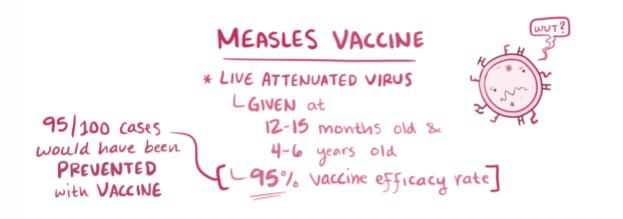
14[edit]
In addition to vaccine, another source of protection for young infants is their mother’s anti-measles immunoglobulin which the fetus gets transplacentally and lasts until about 9 months of age.[11]
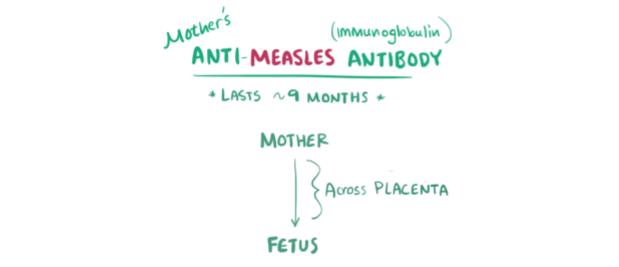
15[edit]
When measles does develop, there isn’t a specific antiviral treatment, instead the medications are generally aimed at treating superinfections, maintaining good hydration with adequate fluids, and pain relief.[6] Some groups are also given vitamin A, like young children and the severely malnourished, which act as an immunomodulator that boosts the antibody responses to measles and decreases the risk of serious complications.[6][2]

16[edit]
Finally, in outbreak settings, both measles vaccine and measles immunoglobulin can be given to household contacts and those at high risk like pregnant women and young infants to help prevent others from getting sick.[6]
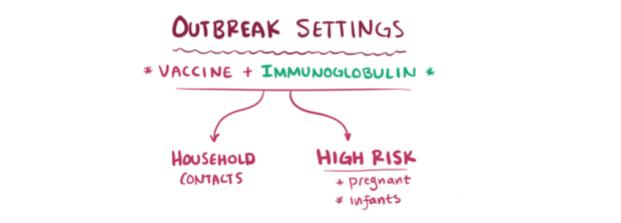
17[edit]
Alright—so a quick review of measles: measles is an airborne pathogen that’s highly contagious, and causes cough, conjunctivitis, and coryza, as well as complications like pneumonia and encephalitis, and can be prevented through vaccination.[1]
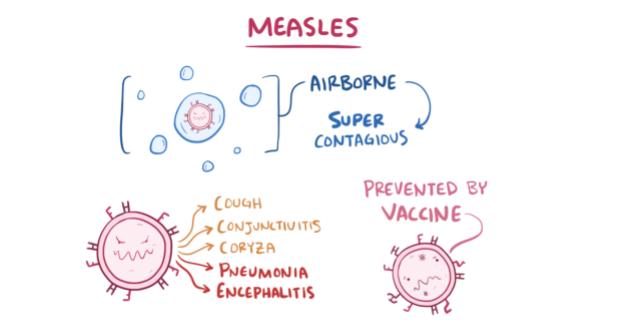
Sources[edit]
- ^ a b c d e f g h i j k l m n o "Pinkbook Measles Epidemiology of Vaccine Preventable Diseases". CDC. 15 November 2016. Retrieved 6 May 2018.
- ^ a b c d "Measles vaccines: WHO position paper – April 2017" (PDF). Releve epidemiologique hebdomadaire. 92 (17): 205–27. 28 April 2017. PMID 28459148.
- ^ a b "Measles". World Health Organization. 28 January 2018. Retrieved 6 May 2018.
- ^ Milner, Danny A. (2015). Diagnostic Pathology: Infectious Diseases E-Book. Elsevier Health Sciences. p. 24. ISBN 9780323400374. Archived from the original on 2017-09-08.
- ^ Marx, John A. (2010). Rosen's emergency medicine: concepts and clinical practice (7th ed.). Philadelphia: Mosby/Elsevier. p. 1541. ISBN 9780323054720.
- ^ a b c d e f g "Measles". CDC. 2 April 2018. Retrieved 6 May 2018.
- ^ a b c d e f g h i j k l Moss, WJ; Griffin, DE (14 January 2012). "Measles". Lancet. 379 (9811): 153–64. doi:10.1016/S0140-6736(10)62352-5. PMID 21855993.
- ^ a b Textbook of Microbiology & Immunology. Elsevier India. 2009. p. 535. ISBN 9788131221631.
- ^ Kaslow, Richard A.; Stanberry, Lawrence R.; Duc, James W. Le (2014). Viral Infections of Humans: Epidemiology and Control. Springer. p. 540. ISBN 9781489974488.
- ^ Schaechter's Mechanisms of Microbial Disease. Lippincott Williams & Wilkins. 2012. p. 357. ISBN 9780781787444.
- ^ a b c d "Measles". Merck Manuals Professional Edition. January 2018. Retrieved 6 May 2018.
- ^ McCance, Kathryn (2014). Pathophysiology : the biologic basis for disease in adults and children (Seventh edition. ed.). Elsevier - Health Sciences Division. p. 1659. ISBN 978-0323088541.
- ^ Nelson, Brett D. (2015). Essential Clinical Global Health, Includes Wiley E-Text. John Wiley & Sons. p. 127. ISBN 9781118638446.
- ^ Gupta, Piyush; Menon, P. S. N.; Ramji, Siddarth; Lodha, Rakesh (2015). PG Textbook of Pediatrics: Volume 2: Infections and Systemic Disorders. JP Medical Ltd. p. 1158. ISBN 9789351529552.
- ^ Griffin, DE (July 2010). "Measles virus-induced suppression of immune responses". Immunological reviews. 236: 176–89. doi:10.1111/j.1600-065X.2010.00925.x. PMID 20636817.
- ^ Rota, Paul A.; Moss, William J.; Takeda, Makoto; de Swart, Rik L.; Thompson, Kimberly M.; Goodson, James L. (14 July 2016). "Measles". Nature Reviews Disease Primers. 2: 16049. doi:10.1038/nrdp.2016.49.
- ^ "Subacute Sclerosing Panencephalitis (SSPE)". Merck Manuals Professional Edition. January 2018. Retrieved 6 May 2018.
